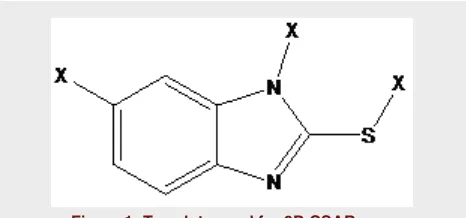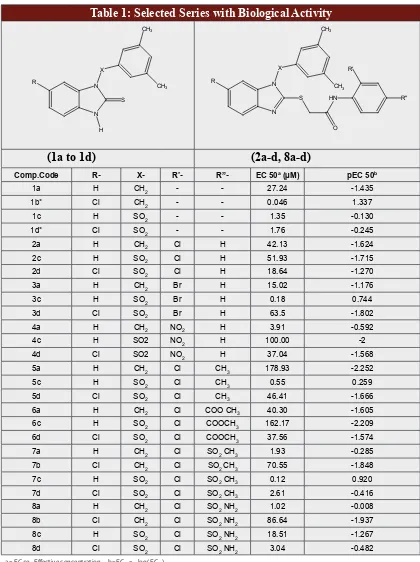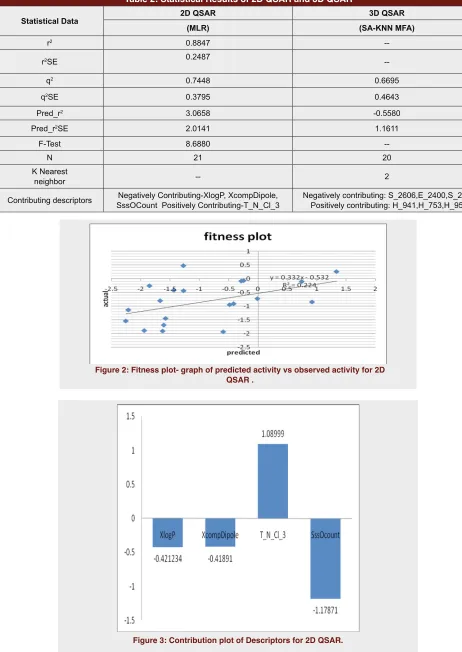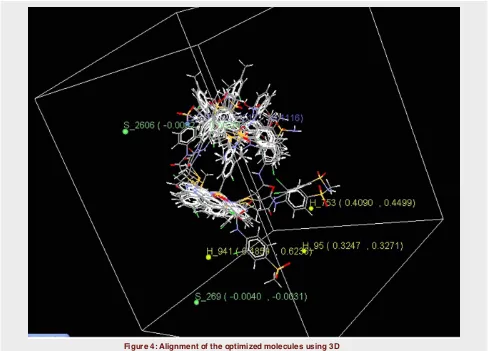www.ijper.org
DOI: 10.5530ijper.51.2s.58 Correspondence:
Shital Patil,
Department of Pharmaceuti-cal Chemistry, A.I.S.S.M.S. College of Pharmacy, Near RTO, Kennedy Road, Pune-411001, Maharashtra, INDIA.
Tel: 9881203150
E-mail: sheetalnikam1212@ yahoo.co.in
Submission Date: 12-12-2016; Revision Date: 14-03-2017; Accepted Date: 10-04-2017 ABSTRACT
Context: Acquired Immuno Deficiency Syndrome (AIDS) is a viral disease caused by Human Immunodeficiency Virus. There is an urgent need to identify newer NNRTIs active against these mutant strains Literature survey has revealed that N1-aryl-benzimidazole analogues have significant potential as HIV-1. Aim: Pharmacophore optimization of Benzimidazole nucleus as non-nucleoside reverse transcriptase inhibitors using Two Dimensional (2D) and Three Dimensional (3D) QSAR. Material & Method: Studies were carried out using V-Life MDS Softwre(4.3 version) using Multiple Linear Regression (MLR) Analysis and Simulated Annealing k Nearest Neighbor Molecular Field Analysis (SA-kNN MFA). Result & Discussion: The model generated for 2D QSAR showed significant statistical parameters such as r2=0.8847, q2=0.7448. The model generated for 3D QSAR showed significant statistical parameter such as q2= of 0.6695. Conclusion: QSAR studies indicated the requirement of certain physicochemical parameters and hydrophobic groups for better Anti HIV activity.
Key words: Molecular Modeling, 2d Qsar, 3d Qsar, Benzimidazole, Anti –HIV.
2D and 3D QSAR of Benzimidazole Analogues as
Novel HIV-1 Non Nucleoside Reverse Transcriptase
Inhibitors
Shital Patil*, Kalyani Asgaonkar, Trupti Chitre, Vedika Bhat, Sayali Ethape, Anagha Sujalegaonkar, Sudeep Bhalekar
Department of Pharmaceutical Chemistry, A.I.S.S.M.S. College of Pharmacy, Near RTO, Kennedy Road, Pune-411001, Maharashtra, INDIA.
INTRODUCTION
Acquired Immuno Deficiency Syndrome (AIDS) is a viral disease caused by Human Immunodeficiency Virus type I (HIV type I) in which in-built defense system of body breaks down completely. HIV-1 virus has more virulence and transmiability than HIV-2 and is prevalent globally. Currently, the most commonly used anti-HIV therapy is through the parallel use of drugs that belongs either to the class of nucleoside/ nucleotide reverse transcriptase inhibi-tors (NRTIs/NTRIs) and non-nucleoside reverse transcriptase inhibitors (NNRTIs), protease or entry inhibitors and HIV inte-grase inhibitors.
NNRTIs are structurally diverse group which are more specific and less toxic com-pounds and binds a specific and allosteric site to the viral enzyme Reverse
Transcrip-tase (RT). NNRTIs non-competitively inhibit RT enzyme, block its mechanism and make it unable to produce a viral DNA. Nevertheless, to date drugs used to treat AIDS under NNRTIs for anti-AIDS ther-apy are Nevirapine, Delaviridine, Efavirenz, Etravirine and more recently Rilpivirine. The therapeutic efficacy of NNRTIs has been limited by the emergence of drug-resistant mutants (such as Y188C, Y181C, K103N, and L100I) and the severe side effects. Therefore there is an urgent need to identify newer NNRTIs active against these mutant strains with improved pharmacoki-netic profile.1,2
revealed that N1-aryl-benzimidazole analogues have sig-nificant potential as HIV-1 non-nucleoside reverse tran-scriptase inhibitors.6-12 Molecular modeling study is an approach that is used to focus on the development of optimal models through variable selection and statistical methods to taper down to highly effective New Chemi-cal Entities (NCE’s). Quantitative Structure-Activity Relationships (QSAR) is a widely accepted tool used for finding associations between chemical structures and biological activity.13 Thus in the present study we have focused on development of Two Dimensional (2D) and Three Dimensional (3D) QSAR studies using Mul-tiple Linear Regression (MLR) Analysis and Simulated Annealing k Nearest Neighbor Molecular Field Analy-sis (SA-kNN MFA), respectively for a series of N1 – aryl- benzimidazole 2-substituted as novel HIV-1 Non Nucleoside Reverse Trascriptase Inhibitors (NNRTI’s).
MATERIALS AND METHODS
Computational Details
All the computational studies were carried out using the V-Life sciences, Molecular Design Suite (MDS) version 4.3.14,15 Molecules were drawn in Chem. Draw Ultra 8.0 and geometry optimization was done using the standard Merck molecular force field (MMFF). The geometry of each molecule was further optimized. The initial con-formations were selected and minimized using the Pow-ell method until the root-mean-square deviation 0.001 kcal/mol Å was achieved.16,17
Data Set
A data set (27molecules) of N1 –aryl- benzimidazole derivatives with varied chemical and biological activities, reported by Monforte Anna-Maria et al for anti-HIV activity, was considered for the QSAR studies.1 Biologi-cal activity expressed in effective concentration (EC) was converted into the corresponding pEC50 (pEC50 = - log ( EC50) values (Table 1). To obtain a predictive QSAR model validation was carried out for which the entire data set was divided into Training and test set using manual selection method. For 2D QSAR 17 molecules were considered in the training set and 5 molecules were considered in test set. For 3D QSAR 20 molecules were considered in the training set and 2 molecules were con-sidered in test set. Uni--Column statistics were gener-ated for uniform representation of the molecules in the training and test sets. While selection of molecules in the training set and test set a care was taken in such a way that biological activities of all compounds in test set lie within the maximum and minimum value range of biological activities of training set of compounds.11
2D QSAR studies
Different models were generated for the 2D-QSAR study using MLR method. The MLR analysis was used to correlate biological activities with physicochemi-cal properties. Various 2D descriptors like topologiphysicochemi-cal, physicochemical, alignment-independent, and atom-type count descriptors were generated for the geometri-cally optimized structures. These generated descriptors were further reduced by removing the invariable col-umns. This was followed by refinement in the selection of descriptors by using the correlation matrix which considers correlation between descriptor with activity as well as correlation between descriptor-descriptor. Variable selection method stepwise forward backward together with MLR regression method was employed to generate statistically significant model.
3D QSAR studies
3D QSAR studies were carried out by kNN MFA method using SA as variable selection method. The selected series of compounds were aligned using the template-based alignment method and template used for alignment is depicted in (Figure 1). Generated mod-els were cross validated using Leave-one-out (LOO) procedure. Different steric, electronic and hydropho-bic points were generated and the model generated was evaluated based on different statistical parameters.
RESULT AND DISCUSSION
2D QSAR: The model generated for 2D QSAR showed significant statistical parameters such as r2=0.8847,
q2=0.7448 (Table 2). 2D QSAR equation was generated along with the fitness plot that indicated the dependence of the biological activity on various different types of the descriptors (Figure 2, Figure 3).
The regression equation obtained is represented as fol-lows:
pEC50 = 1.0899 T_N_Cl_3-1.1787 SssOCount -0.4212 XlogP -0.4189 X comp Dipole - 4.8498.
Contribution of descriptors
T_N_Cl_3- This descriptor signifies that chlorine should be separated from Nitrogen by 3 bond distance. It is a positively contributing descriptor with a contribu-tion of 35.06%.
SssOCount- This descriptor defines the total no of Oxygen connected with 2 single bonds. Negative Con-tribution of this descriptor was 37.91%.
XlogP- This is atom based evaluation of logP. This descriptor signifies ratio of solute concentration in octanol and water and generally termed as Octanol
Table 1: Selected Series with Biological Activity
N N
S
H
CH3
CH3 R
X
N N
S HN
O X
CH3
CH3 R
R'
R"
(1a to 1d)
(2a-d, 8a-d)
Comp.Code R- X- R’- R”- EC 50a (µM) pEC 50b
1a H CH2 - - 27.24 -1.435
1b* Cl CH2 - - 0.046 1.337
1c H SO2 - - 1.35 -0.130
1d* Cl SO2 - - 1.76 -0.245
2a H CH2 Cl H 42.13 -1.624
2c H SO2 Cl H 51.93 -1.715
2d Cl SO2 Cl H 18.64 -1.270
3a H CH2 Br H 15.02 -1.176
3c H SO2 Br H 0.18 0.744
3d Cl SO2 Br H 63.5 -1.802
4a H CH2 NO2 H 3.91 -0.592
4c H SO2 NO2 H 100.00 -2
4d Cl SO2 NO2 H 37.04 -1.568
5a H CH2 Cl CH3 178.93 -2.252
5c H SO2 Cl CH3 0.55 0.259
5d Cl SO2 Cl CH3 46.41 -1.666
6a H CH2 Cl COO CH3 40.30 -1.605
6c H SO2 Cl COOCH3 162.17 -2.209
6d Cl SO2 Cl COOCH3 37.56 -1.574
7a H CH2 Cl SO2 CH3 1.93 -0.285
7b Cl CH2 Cl SO2 CH3 70.55 -1.848
7c H SO2 Cl SO2 CH3 0.12 0.920
7d Cl SO2 Cl SO2 CH3 2.61 -0.416
8a H CH2 Cl SO2 NH2 1.02 -0.008
8b Cl CH2 Cl SO2 NH2 86.64 -1.937
8c H SO2 Cl SO2 NH2 18.51 -1.267
8d Cl SO2 Cl SO2 NH2 3.04 -0.482
Table 2: Statistical Results of 2D QSAR and 3D QSAR
Statistical Data 2D QSAR 3D QSAR
(MLR) (SA-KNN MFA)
r2 0.8847
--r2SE 0.2487
--q2 0.7448 0.6695
q2SE 0.3795 0.4643
Pred_r2 3.0658 -0.5580
Pred_r2SE 2.0141 1.1611
F-Test 8.6880
--N 21 20
K Nearest
neighbor -- 2
Contributing descriptors SssOCount Positively Contributing-T_N_Cl_3Negatively Contributing-XlogP, XcompDipole, Negatively contributing: S_2606,E_2400,S_269 Positively contributing: H_941,H_753,H_95
Figure 3: Contribution plot of Descriptors for 2D QSAR.
Figure 4: Alignment of the optimized molecules using 3D QSAR.
Water partition Coefficient. Negative Contribution of this descriptor was 13.54%.
X comp Dipole- X Component of Dipole moment. Negative Contribution of this descriptor was 13.47%. The higher frequency of occurrence of positively con-tributing descriptors in NCE’s may lead to increase in biological activity whereas the negatively contribut-ing descriptors should be avoided while designcontribut-ing the NCE’s.
3D QSAR
The energy minimized molecules were properly aligned on the selected template (Figure 4). The model gener-ated for 3D QSAR showed significant statistical param-eter such as q2 of 0.6695 (Table 2).
Interpretation of 3D QSAR studies
In 3D QSAR studies, 3D data points generated around Benzimidazole pharmacophore were used to optimize the electrostatic and steric requirements of the Benz-imidazole nucleus for anti-HIV activity. The points gen-erated in KNN MFA 3D QSAR model are negatively
contributing S_2606,E_2400,S_269 and Positively con-tributing H_941,H_753,H_95 (Figure 3b).
These points suggested the significance and require-ment of less electrostatic, steric and more hydrophobic groups for maximum biological activity of Benzimid-azole analogues.
The points generated around the pharmacophore were used to correlate chemical nature of substituents around benzimidazole ring with their observed activity.
CONCLUSION
ACKNOWLEDGEMENT
Authors are thankful to Dr. Ashwini. R. Madgulkar, Principal AISSMS College Of Pharmacy, Pune, India of our institute for continuous motivation, support, and for providing the necessary infrastructure to carry out this work.
CONFLICT OF INTEREST
The authors declare no conflicts of interest.
ABBREVIATIONS USED
HIV type I: Human Immunodeficiency Virus type
I; QSAR: Quantitative structure–activity relation-ship; MLR: Multiple Linear Regression; kNN MFA:
k Nearest Neighbor Molecular Field Analysis; AIDS:
Acquired Immuno Deficiency Syndrome; HIV-2;
NRTIs/NTRIs: Nucleoside/nucleotide reverse tran-scriptase inhibitors; NNRTIs: Non-nucleoside reverse transcriptase inhibitors; NCE’s: New Chemical Enti-ties; MDS: Molecular Design Suite; MMFF: Merck molecular force field; EC: Effective concentration; SA:
Simulated annealing.
REFERENCES
1. Monforte A, Ferro S, Luca L, Surdo G, Morreale F, Pannecouque C, et al. Design and synthesis of N1 –aryl- benzimidazole 2-substituted as novel HIV-1 Non Nucleoside Reverse Transcriptase Inhibitors. Bio-organic and Medicinal Chemistry. 2014;22(4):1459-67. https://doi.org/10.1016/j.bmc.2013.12.045 ; PMid:24457088.
2. Murugesan V, Makwana N, Suryawanshi R, Saxena R, Tripathi R, Paranjape R, et al. Rational design and synthesis of novel thiazolidin-4-ones as non-nucleoside HIV-1 reverse transcriptase inhibitors, Bioorganic and Medicinal Chemistry. 2014;22:3159-70. https://doi.org/10.1016/j.bmc.2014.04.018 ; PMid:24794742.
3. Gadhave R, Vichare V, Joshi S. Synthesis and Biological Evaluation for Antihistaminic activity of N1-Alkyl-2(N4- Alkyl/Aryl piperazinyl methyl) Benzimidazole derivatives R(S). Asian Journal of Research in Chemistry 2012;5(7):918-21.
4. Roth T, Morningstar M, Boyer P, Hughes S, Buckheit R Jr, Michejda C. Synthesis and biological activity of novel nonnucleoside inhibitors of HIV-1 reverse transcriptase. 2-Aryl-substituted benzimidazoles. Journal of Medicinal Chemistry. 1997;40(26):4199-207. https://doi.org/10.1021/ jm970096g ; PMid:9435891.
5. Ding K, Wang A, Boerneke M, Dibrov S, Hermann T. Aryl-substituted aminobenzimidazoles targeting the hepatitis C virus internal ribosome entry site . Bioorganic and Medicinal Chemistry. 2014;24(14):3113-7. https://doi. org/10.1016/j.bmcl.2014.05.009 ; PMid:24856063 PMCid:PMC4096041. 6. Barreca M, Rao A, De Luca L, Zappala M, Monforte A, Pannecouque MGC,
et al. Computational strategies in discovering novel non-nucleoside inhibitors
of HIV-1 RT. Journal of Medicinal Chemistry. 2005;48(9):3433-7. https://doi. org/10.1021/jm049279a ; PMid:15857150.
7. Barreca M, Rao A, De Luca L, Zappala M, Monforte A, Maga G, et al. Discovery of novel benzimidazolones as potent non-nucleoside reverse transcriptase inhibitors active against wild-type and mutant HIV-1 strains. Bioorganic and Medicinal Chemistry. 2007;17(7):1956-60. https://doi. org/10.1016/j.bmcl.2007.01.025 ; PMid:17276064.
8. Monforte A, Logoteta P, Ferro S, De Luca L, Iraci N, Monforte AM, et al. Design, synthesis, and structure-activity relationships of 1,3-dihydrobenzimidazol-2-one analogues as anti-HIV agents. Bioorganic and Medicinal Chemistry. 2009;17(16):5962-7. https://doi.org/10.1016/j.bmc.2009.06.068 ; PMid:19616956.
9. Monforte A, Rao A, Logoteta P, Ferro S, De Luca L, Barreca M, et al. Novel N1-substituted 1,3-dihydro-2H-benzimidazol-2-ones as potent non-nucleoside reverse transcriptase inhibitors. Bioorganic and Medicinal Chemistry. 2008;16(15):7429-35. https://doi.org/10.1016/j.bmc.2008.06.012; PMid:18585918.
10. Barreca M, De Luca L, Iraci N, Rao A, Ferro S, Maga G, et al.
Structure-based pharmacophore identification of new chemical scaffolds as
non-nucleoside reverse transcriptase inhibitors. Journal of Chemical Information and Modelling. 2007;47(2):557-62. https://doi.org/10.1021/ci600320q ; PMid:17274611.
11. Monforte A, Logoteta P, De Luca L, Iraci N, Ferro S, Maga G, et al. Novel 1,3-dihydro-benzimidazol-2-ones and their analogues as potent non-nucleoside HIV-1 reverse transcriptase inhibitors. Bioorganic and Medicinal Chemistry. 2010;18(4):1702-10. https://doi.org/10.1016/j.bmc.2009.12.059 ; PMid:20097079.
12. Samuele A, Crespan E, Vitellaro S, Monforte A, Logoteta P, Chimirri A, et al. Slow binding-tight binding interaction between benzimidazol-2-one inhibitors and HIV-1 reverse transcriptase containing the lysine 103 to asparagine mutation. Antiviral Research. 2010;86(3):268-75. https://doi.org/10.1016/j. antiviral.2010.03.008 ; PMid:20307579.
13. Pawar V, Lokwani D, Bhandari SV, Mitra D, Sabde S, Bothara K, et al. Design of potential reverse transcriptase inhibitor containing Isatin nucleus using molecular modeling studies. Bioorganic and Medicinal Chemistry. 2010;18(9):3198-211. https://doi.org/10.1016/j.bmc.2010.03.030 ; PMid:20381364.
14. V Life MDS; Molecular Design Suite version 3.5. V-life Sciences Technologies Pvt. Ltd., Pune, India, 2004. www.vlifesciences.com
15. Inamdar P, Bhandari S, Sonawane B, Hole A, Jadhav C. Structure
Optimization of Neuraminidase Inhibitors as Potential Anti-Influenza
(H1N1Inhibitors) Agents Using QSAR and Molecular Docking Studies. Iranian Journal of Pharmaceutical Research. 2014;13(1):49-65. PMid:24734056 PMCid:PMC3985258.
16. Halgren TA. Merck molecular force field. II. MMFF94 van der Waals
and electrostatic parameters for intermolecular interactions. Journal of Computational Chemistry. 1996;17(5-6):520-52. https://doi.org/10.1002/ (SICI)1096-987X(199604)17:6<520::AID-JCC2>3.3.CO;2-W.
Cite this article: Patil S, Asgaonkar K, Chitre T, Bhat V, Ethape S, Sujalegaonkar A, Bhalekar S. 2D and 3D QSAR of Benzimidazole Analogues as Novel HIV-1 Non Nucleoside Reverse Transcriptase Inhibitors. Indian J of Pharmaceutical Education and Research. 2017;51(2s):122-8.
SUMMARY
• Molecular modelling approach was used to design novel Benzimidazole analogues as anti HIV agents. The present study was aimed to derive 2D and 3D QSAR models for optimization of pharmacophore to identify key structural fragments required for anti HIV activity . Two Dimensional (2D) and three dimensional (3D) Quantitative structure–activity relationship (QSAR) studies were carried out for a series containing benzimidazole nucleus with Anti-HIV Activity using Multiple Linear Regression (MLR) and k Nearest Neighbor Molecular Field Analysis (kNN MFA)method respectively. Results obtained from statistically significant models were used to derive the optimized benzimidazole phar-macophore for better Anti HIV activity.
Shital Patil- M.Pharm: Assistant Professor in Dept. of Pharmaceutical chemistry. Her area of research includes drug design, synthesis of Anti HIV and Anti TB entities.
About Authors
PICTORIAL ABSTRACT
Kalyani Asgaonkar- M.Pharm: Assistant Professor in Dept. of Pharmaceutical chemistry. Her area of research includes drug design, synthesis of Anti HIV and Anti TB entities.
Dr.Trupti Chitre- M.Pharm, Ph.D: Associate Professor in Dept. of Pharmaceutical chemistry. Her area of research includes drug design, synthesis of Anti HIV and Anti TB entities.
Vedika Bhat: Undergraduate students of AISSMS College of Pharmacy.
Sayali Ethape: Undergraduate students of AISSMS College of Pharmacy.
Sudeep Bhalekar: Undergraduate students of AISSMS College of Pharmacy.



